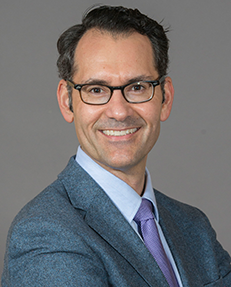Building a mental health system in Ontario
By Kim Barnhardt
If Dr. Paul Kurdyak has his way, by the time he retires, Ontario will have an integrated mental health system to support people in the province who struggle with mental health and substance use issues.

Although there are many mental health and addictions services in the province, they are not integrated, leading to a patchwork of supports and programs, according to Dr. Kurdyak, OSSU’s Mental Health and Addictions Initiative lead. As Vice-President, Clinical at Ontario’s Mental Health and Addictions Centre of Excellence, IC/ES lead in mental health and addictions research, and a psychiatrist at the Centre for Addition and Mental Health (CAMH), Dr. Kurdyak is well-positioned to lead this change.
More than 1 million Ontarians experience mental health and addictions challenges, which contribute to workplace absences, lower economic productivity, and most importantly, poorer quality of life as well as risk of death for some people.
“A lot of my work feels like quantitative journalism by putting numbers to people’s experiences of poor access – only 40% of suicide attempts get care within 6 months,” says Dr. Kurdyak.
Behind this sobering number – which represents real people who need urgent mental health care – are many questions that don’t yet have answers: who needs care, who is accessing care, how long are people waiting for care, are they receiving quality care, are they getting better from this care?
The creation of the Mental Health and Addictions Centre of Excellence will be key to weave together the province’s disparate services and supports into a system that allows people to access high-quality care throughout their lives, and to answer those questions. Based on the successful Cancer Care Ontario model, which was created to provide consistent care amongst the fragmented services and data available in the early 2000s, the Centre of Excellence will bring the same consistency to mental health and addictions.
Patient partnership
Patient engagement in mental health is critical to success. A leader in patient engagement, the mental health sector has benefited from the lived experience of patients and families, especially in youth mental health.
“Mental health has paved the way in patient-partnered research,” says Augustina Ampofo, a member of OSSU’s new Patient Partner Advisory Council (PPAC) and youth engagement specialist at the Centre for Addiction and Mental Health (CAMH). “CAMH is at the forefront – it has been doing patient and family engagement and feedback in how to improve services for a long time.”

As someone who has experienced a mental health crisis, and was able to access support early on, she is well-placed to provide unique, valuable insights into mental health research and to support youth with mental health issues.
“I’ve been working casually in the mental health space for 5 plus years and use my own experience. I experienced psychosis and was hearing voices 24 hours a day. I was lucky to be able to access the Early Psychosis Intervention program at St. Joe’s in Burlington.”
OSSU’s role in funding pilot projects with patient partners, like the implementation trial for early psychosis intervention (Early Psychosis Intervention: Spreading Evidence-based Treatment (EPI-SET)), will help build a foundation for this system. The EPI-SET study shows the success of a standardized, team-based model of care for early psychosis intervention that could be implemented and scaled in the province.
For Augustina, the opportunity to strengthen mental health research through OSSU and make change is energizing.
“I’m most excited about to see the growth of patient engagement in Ontario. A lot of people like to talk about patient engagement in research – I’m excited about learning and seeing how to engage patients in a real way, not tokenistic.
I’d love to see streamlining of early psychosis care across Canada so that anyone going through first episode can access good quality care anywhere, anytime,” she adds.
Health human resources
A smooth functioning mental health and addictions system will not be possible without enough family physicians, who deliver the majority of mental health care in the province’s formal health system, and psychiatrists with their specialized focus. What is essential, however, is not to simply add more physicians, but to ensure that the practice models support physicians to practice the best medicine. With high levels of physician burnout, crushing administrative burdens, changing practice patterns and inadequate physician remuneration, that will be a challenge.
But there are potential solutions.
Team-based care, such as family health teams and community health centres, has shown great promise, validated by both evidence and physician satisfaction.
“Physicians need support to work at full capacity, which includes reducing administrative burden, and that’s increasing as complexity of care increases. Team-based models and collaborative mental health teams are supported by the evidence and could support care provision,” says Dr. David Rudoler, Research Chair, Population Health and Innovation in Mental Health, Ontario Shores in Whitby, Ontario.
As well, the way we pay physicians is a deterrent to the type of care that many people need. In research currently underway, Dr. Rudoler’s team hears repeatedly that family physicians and psychiatrists don’t like fee-for-service.
In addition to the well-known issue of burnout reported by family physicians, psychiatrists, who treat very complex patients yet are the lowest paid physicians in Ontario, are suffering.
“Fee-for-service doesn’t reward complex care of patients,” says Dr. Rudoler. “We’ve created a system that doesn’t encourage people to do the right thing – we hope they’ll do the right thing. Why would we set up a system that would not encourage people to do the work they want to do? Simple and complex patients are paid the same, similar to primary care, with the same fee despite a complex diagnosis.”
He says psychiatrists want to work in collaborative mental health models with other providers, often in primary care teams – in a team model – as it allows them to work at full scope and to handle complex cases.
“There is lots of overlap between psychiatry and primary care – it’s about the whole person,” says Dr. Rudoler. “But the system handcuffs them.”
“I think we have to increase the workforce to meet the growing demands but it won’t solve the problem as family physicians and psychiatrists are reacting to disincentives to practice; we’ve set up a system to disincentivize the work they want to do.”
What do we do now?
To build a mental health system, we need to take a more wholistic approach in supporting family physicians to provide mental health care, taking a page from other disease playbooks.
“To what extent are family docs trained in this [mental health care]?” explains Dr. Kurdyak. “If a person with diabetes comes in and doesn’t respond to first line treatment, I know how to access specialists. If someone with a mental health issue doesn’t respond to what I provide, I don’t have access to a specialist like a psychiatrist – no one has my back. The end result is that patients with more complex mental health issues do not get the same access to, and quality of care, that individuals with physical illnesses like diabetes have.”
“I work in a psychiatric Emergency Department and I do health systems research and the problems are very clear. I was frustrated that none of the problems were being addressed. Now I’m on the solutions side so I’m no longer frustrated, but just stressed,” says Dr. Kurdyak.
His plan is to continue to iteratively apply the provincial program playbook that has led to excellence in the delivery of cancer and cardiac care to mental health services. “Over decades, the cancer system has evolved to be constantly learning. Every cancer patient both benefits from and contributes to the constantly evolving evidence that is generated by the cancer learning health system. This was made possible by a lot of critical infrastructure – clinical expertise, data systems, analytics. This same infrastructure is also enabling OSSU-type population-based clinical trials. Our goal in the long-term is to build the same infrastructure and supports so that mental health care quality is improved, partly by OSSU-funded implementation research.”
Dr. Kurdyak’s team has launched a committee of experts, including individuals with lived and living experience, to support OSSU research proposals focusing on mental health and substance use issues. This is an important first step in building momentum to address the multitude of issues related to mental health service quality.
What are the timelines for this potential new mental health system?
“We’ll have the infrastructure built in 2 to 3 years when we can start this research,” explains Dr. Kurdyak. “In 10 years, we’ll have built a machine and shown it works in 4 or 5 different areas, if we have the opportunity to continue. At that point, I’ll be ready to hand it over to the next generation.”
He summarizes his grand vision another way.
“In 1 year, it will be implemented, in 5 years people will understand it, and in 10 years it will be ready. Then I will retire,” he adds jokingly.
That’s a remarkable legacy to envision as he works with partners to make this a reality in Ontario.